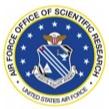AFOSR

Experimental Investigation and Characterization of Stall Cell Formation
Secondary Flow Structures Due to Interaction Between a Finite-Span Synthetic Jet and a 3-D Cross Flow
Flow Physics and Control of Three-Dimensional Separation on Swept Wings
Three-dimensional separation over three-dimensional wings at a moderate Reynolds number
This project is an experimental investigation of separated flows over cantilevered wings with a cross-section NACA 0015. The goal of this research is to link changes in the separated flow field to variations in aspect ratio, angle of attack, Reynolds number, sweep angle, and taper ratio. The results include qualitative surface topology from oil flow visualization, quantitative flowfield measurements using Stereo Particle Image Velocimetry (SPIV) and Time-Resolved Stereo Particle Image Velocimetry.